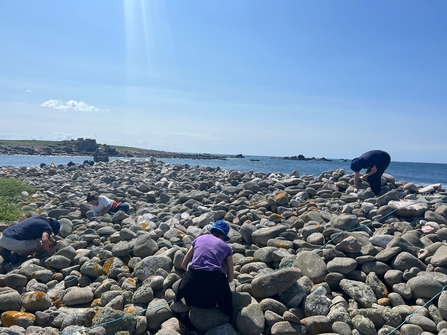The 2023 survey found:
- Overall declines of nearly 20% in the 8 years since the previous survey.
- A dramatic loss of almost half the islands’ seabirds over the last 30 years.
- Common terns lost as an annual breeder, with kittiwakes likely to follow soon.
- Steep declines in our gull populations since 2015, including the amber-listed greater black-backed gull (38%), and lesser black-backed gull (58%) and the red-listed herring gull (40%).
The survey confirms that the islands still hold one of the most significant seabird colonies in England but reflect a pattern of decline over 30 years. Fewer than 7,000 breeding pairs of seabirds remain on the islands.
Scilly supports one of the largest breeding colonies of shags in the UK, but numbers across the islands have declined by over a third since 2015. These declines are in line with national trends, representing wider issues with the health of our oceans and lack of action to protect nature.
Where action has been taken to restore island habitats – for example successful rat removal on St Agnes and Gugh – burrow nesting seabirds have experienced a remarkable recovery. Storm petrels and Manx shearwaters, both amber-listed as birds of conservation concern and with significant UK breeding populations on Scilly, have seen significant increases with Manx shearwater numbers doubling in the last 8 years.
The presence of 105 pairs oystercatcher & 24 pairs of ringed plover underlines the importance of Scilly as the most important wader stronghold in south west England.
The findings, made possible by Natural England funding and the close working of the Isles of Scilly Area of Outstanding Natural Beauty partnership, demonstrate the need for a comprehensive island restoration project to remove rats in order protect our most vulnerable seabirds. Ending rat predation on seabird eggs and chicks across the remainder of seabird-nesting islands would yield enormous benefits. The findings also highlight the need to understand pressures that may be linked to the health of the marine environment that feeds our seabirds.
Responding to the report, Dr Vickie Heaney, Isles of Scilly Wildlife Trust (IoSWT) Seabird Ecologist, said: "The wealth of data provided by such a comprehensive survey means we can be confident in our assessment that our seabirds are under threat. The evidence of storm petrel and Manx shearwater success on St Agnes and Gugh and our rat free islands like Annet is clear – rat removal works. The 2023 results are a call-to-action for collective future island restoration projects if we are to fulfil our vital role as a place of safe breeding for our seabirds and meet the challenges our wildlife faces."
Paul St Pierre, Conservation Officer, RSPB said: “The Isles of Scilly are a very special place for seabirds and this latest survey adds to long term information highlighting their differing fortunes. Establishing a funded biosecurity plan for all the islands will make the islands a safer place for seabirds to breed and improve their resilience in the face of increasing climate challenges. Landscape Recovery funding is one of the few opportunities that could support a collaboration between organisations, local communities and businesses to secure the future of the islands’ seabirds in this way and help the delivery of key government objectives for wildlife.”“
Tony Richardson, Chair, Isles of Scilly AONB Partnership, said: “So much has been achieved for seabirds in the Isles of Scilly through island restoration and it is heartening to see the positive impact our efforts have had on Manx shearwaters and storm petrels. This success when seen alongside the overall findings of a further decade of declines show an urgent need for wholescale and island-wide action. Now more than ever it is important that we scale up our ambitions and work together to improve breeding success for Scilly’s seabirds and protect their future.”
Justin Hart, Natural England, said: “Comprehensively surveying the Isles of Scilly seabird population is a complex task and it is testimony to the partnership working of those involved on the ground that a complete assessment has been made this year. Unfortunately the results show that alongside the winners a number of the most nationally and internationally important seabird populations are under pressure and are in steep decline. The survey highlights the importance of monitoring our seabirds so we can identify trends. The findings are also a reminder of both the urgent need to restore and recover nature, and that doing so will require addressing pressures on both land and at sea.”
The 2023 survey was carried out in partnership between IOSWT and the RSPB. It was principally funded by Natural England and the Isles of Scilly AONB Partnership, with match-funding being provided by the Isles of Scilly Wildlife Trust and the RSPB.
Read more about our Seabird Recovery Project here, and you can check out the full report below:

